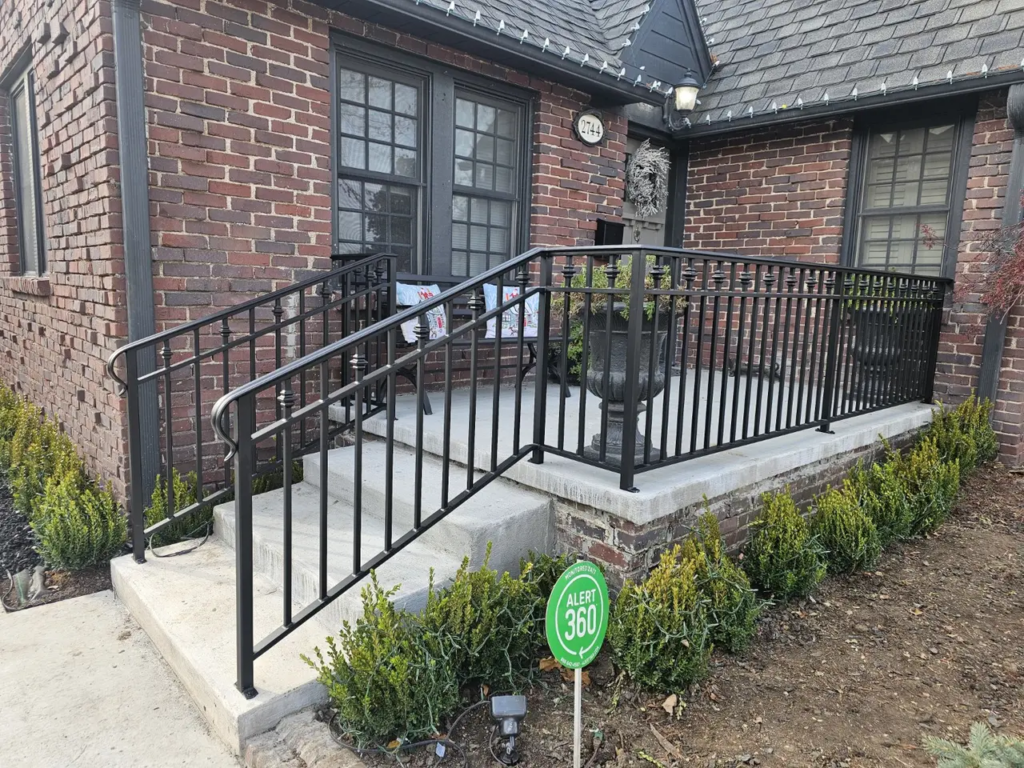
The Art of Iron Railing Design: Historical Inspiration for Modern Homes
Introduction to Iron Railing Design
Iron railing design, a blend of strength and beauty, has been adorning homes and public buildings for centuries. Initially, iron railings served primarily as protective barriers, offering security for the inhabitants within. However, as time progressed, the artistic potential of ironwork began to be explored more fully. Artisans started incorporating intricate designs, drawing inspiration from various historical periods and styles. From the ornate patterns of the Victorian era to the sleek lines of modern design, iron railings have evolved significantly. Today, iron railings are not just about safety; they are also a statement of style. They can add a touch of elegance or a dash of historical charm to a home, depending on the design chosen. Whether it’s the flowing curves found in traditional styles or the minimalist approach of contemporary designs, iron railings offer a unique blend of durability and design flexibility, making them a favored choice for both historical restorations and modern architectural projects.
The Historical Significance of Iron Railings
Iron railings have been a symbol of affluence and grace since historic times. Their journey from the lavish estates of the European aristocracy to today’s modern homes is steeped in history and tradition. Initially, these structures were exclusive to the wealthy, highlighting the divide between different social classes. Over centuries, ironwork has evolved, but it retains a nod to its majestic past. In medieval times, blacksmiths became revered for their skill in forging intricate designs, making each railing piece not just a safety feature but a work of art. By the 16th and 17th centuries, as trade and technology advanced, iron railings became more accessible, yet they continued to signify elegance and high status. Today, when we incorporate iron railings into modern homes, we’re not just choosing a safety feature or an aesthetic addition; we’re embracing a piece of history. This connection to the past enriches our living spaces, adding depth and a timeless elegance that transcends trends. Whether it’s the intricate patterns influenced by the Baroque and Rococo periods or the more minimalistic designs inspired by modernist movements, the historical significance of iron railings continues to inspire homeowners and designers alike, proving that some things never go out of style.
Ancient Inspirations: Ironwork in History
Iron railing design has roots deep in history, borrowing from the ages to inspire modern homes. Long ago, civilizations like the Romans and the Greeks used iron for tools and weapons. Yet, their influence on ironwork in architecture cannot be understated. These ancient cultures showcased their wealth and sophistication through elaborately designed gates and railings, marking the beginning of decorative ironwork.
Fast forward to the medieval period, blacksmiths mastered the art of bending and twisting iron into intricate patterns. This skill was not just about functionality but also about making a statement. Castles and cathedrals were adorned with ironwork that told stories of power, faith, and artistry.
The Renaissance era brought a revival of classical ideas and techniques, pushing ironwork designs to new heights. Craftsmen began to incorporate more elaborate designs, including floral patterns, animal figures, and geometric shapes, reflecting the era’s broader artistic movements.
In the 18th and 19th centuries, the Industrial Revolution made iron more accessible and affordable. This allowed for even more creativity in iron railing designs, with the Victorian era, in particular, being known for its elaborate and ornate ironwork, a trend that was as much about showing off as it was about craftsmanship.
Today’s iron railing designs often nod to these historical influences, blending ancient motifs with contemporary aesthetics. This connection to the past adds depth and character to modern homes, proving that good design is timeless. Whether it’s a simple, functional railing or an elaborate, decorative piece, the ancient inspirations in ironwork remind us of our enduring desire to combine beauty and utility.
The Renaissance of Iron Railing in Modern Architecture
Iron railing, once the hallmark of Renaissance architecture with its intricate designs and robust construction, has found its way back into modern homes, making a striking resurgence. This renaissance in contemporary architecture isn’t just about borrowing a style from the past. It’s about blending time-honored designs with modern aesthetics and functionality. During the Renaissance, iron railings were a symbol of wealth and craftsmanship, showcasing elaborate patterns and the skills of the ironworkers. Today, these designs inspire modern architects and designers to create spaces that feel both luxurious and secure. The beauty of incorporating iron railing into modern architecture lies in its versatility. Whether it’s a minimalist home looking for that touch of elegance or a more traditional space seeking authenticity, iron railing fits seamlessly, offering durability and timeless appeal. Its ability to adapt to various styles makes it a favorite among today’s homeowners and builders. Moreover, modern technology has allowed for enhancements in metalwork, making today’s iron railings more resistant to weather and wear, ensuring they not only look exquisite but last for generations. This fusion of historical inspiration with contemporary innovation encapsulates the true essence of modern architecture’s renaissance through iron railing design.
Styles and Patterns: From Classic to Contemporary
Iron railings have style, no question. They can be as simple or as detailed as you want. Let’s talk about the range, from old-school classics to the sleek lines of modern design. First up, traditional styles. Think of the intricate patterns you see in old European estates or Victorian homes. These designs are all about details – swirls, leaves, and flowers that catch the eye and don’t let go. They scream elegance and are perfect if you’re going for that timeless look. On the flip side, contemporary designs are all about clean lines and minimalism. Less is more here. You’ll see straight lines or simple curves, nothing too busy, fitting perfect in today’s modern homes. Whether it’s a balcony, stairway, or fence, the design you choose speaks volumes. It’s not just a railing; it’s a statement. So, what’s your style? Classic elegance or modern simplicity?
The Craftsmanship Behind Iron Railing Design
Crafting iron railings is an art that merges tradition with innovation. For centuries, blacksmiths have heated and hammered iron into intricate designs, drawing inspiration from the world around them. The process begins with raw, malleable iron. Blacksmiths heat this iron in a forge until it’s red-hot. This makes the metal soft and easier to shape. Using hammers, anvils, and their own skilled hands, these artists then bend, twist, and cut the iron into intricate patterns and shapes.
Historical designs often feature scrolls, leaves, and flowers, showcasing the blacksmith’s ability to mimic natural beauty in a durable form. These elements not only add to the aesthetic appeal but also demonstrate the technical proficiency required to manipulate iron so delicately.
In modern homes, iron railings serve as a bridge between the past and present. The craftsmanship behind each piece tells a story of heritage, skill, and creativity. Whether it’s a sleek, contemporary design or a more elaborate, classical pattern, the underlying process remains a testament to the artisan’s dedication to their craft. Iron railing design is not just about creating a functional barrier; it’s about adding a touch of elegance and history to a space. Through their work, modern blacksmiths keep the ancient art alive, adapting it to suit today’s tastes while honoring timeless techniques.
Innovations in Iron Railing Design for Modern Homes
Today’s iron railing designs have taken a massive leap forward from their traditional roots. Architects and designers are now blending history with modernity, crafting railings that are not only safe and sturdy but also works of art. Innovations in technology have allowed for more intricate patterns, sleeker lines, and customization that was once impossible. For example, laser cutting technology enables the creation of precise and complex patterns that can mimic historical designs or bring to life contemporary visions. Powder coating finishes in a wide range of colors can make iron railings both durable and visually appealing, contrasting or complementing a home’s design. Additionally, integrating materials like glass or wood with iron opens up a realm of possibilities, offering the perfect balance between strength and aesthetic appeal. These advancements mean that homeowners now have the opportunity to inject personality and flair into their spaces with iron railings that reflect both their style and the latest in design innovation.
Choosing the Right Iron Railing Design for Your Home
Choosing the right iron railing design for your home means thinking about your home’s style and what story you want it to tell. Iron railings are not just safety features; they’re a way to add beauty and character. Whether you live in a modern loft or a classic Victorian manor, there’s an iron railing design that fits your space.
Start by considering the architecture of your home. A sleek, straight-line design works well for modern homes, while more ornate patterns are a perfect match for traditional styles. Think about the vibe you’re going for. Do you want something bold and striking, or something more subtle and understated?
Don’t forget about durability and maintenance. Iron railings can last for decades with proper care, but they do need to be treated to prevent rust. Choose a finish that complements your home and can withstand the weather in your area.
Last but not least, think about your budget. Custom designs are stunning but can be pricier. Pre-made options might be more budget-friendly and still offer the charm and character you’re looking for.
In sum, the right iron railing design can elevate your home’s exterior, reflect your personal style, and provide security. Take your time to browse through different designs and consult with a professional to make the best choice for your home.
Installation and Maintenance of Iron Railings
Installing iron railings is straightforward but requires professional handling to ensure they are securely mounted. Initially, the area is measured precisely to make sure the railings will fit perfectly. Holes are then drilled into the ground or wall, where the railings will be anchored. After the railings are placed, they are bolted or welded into position, providing a strong, long-lasting barrier. On the maintenance side, iron railings demand attention to prevent rust and maintain their beauty. Regular cleaning with soapy water helps remove dirt and grime. Applying a coat of metal paint every few years prevents rust and keeps the railings looking fresh. If rust does appear, it’s important to sand it down and apply a rust-inhibitor primer and paint to stop the spread. By attending to these steps, your iron railings will remain both sturdy and attractive for years, blending historical charm with modern safety standards.
Conclusion: Blending Tradition with Modernity in Iron Railing Design
In conclusion, the journey of iron railing design is a fine example of how we can blend tradition with modernity. Historically, iron railings have been a symbol of strength and elegance. Today, they continue to reflect those qualities while embracing contemporary designs and techniques. It’s not just about choosing a design; it’s about weaving a story and creating a connection between the past and the present. Whether you’re drawn to the intricate patterns of Victorian railings or lean towards the sleek, minimalistic lines of modern design, there’s room to innovate while paying homage to the roots of ironwork. By incorporating elements of historical inspiration, modern homes can feature iron railings that are not only functional but also powerful storytelling pieces. This fusion of old and new ensures that while our homes look towards the future, they never forget the craftsmanship and beauty of the past.
